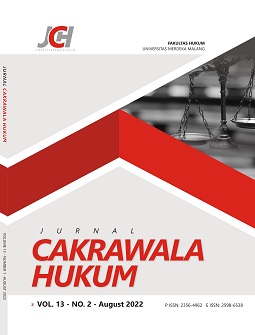Model Countermeasures Children which Commit Crimes in Review Restorative Justice
DOI:
https://doi.org/10.26905/idjch.v14i2.10783Keywords:
Child, Countermeasures Model, Restorative Justice.Abstract
This study describes the model settlement of cases through non-penal channels for crimes committed by children according to Act 11 of 2012 concerning the Juvenile Criminal Justice System with prioritizing restorative justice so that children who commit crimes are not stigmatized negatively. The Juvenile Criminal Justice System concept has included solving problems in a family manner or for children in conflict with the law, formally known as diversion. Diversion exists to divert the settlement of child cases from the criminal justice process to processes outside criminal justice. Diversion exists to prevent children who conflict with the law from the negative impacts of the criminal justice process on children. United Nations Standard Minimum Rules for the Administration of Juvenile (The Beijing Rules) have provided guidelines to prevent children in conflict with the law from negative impacts, namely by giving law enforcers the authority to take action in handling or resolving the problems the child offenders by not taking courts, among others stopping or not continuing or releasing or returning or handing over to society and other forms of social service activities.
How to cite item: Kaimuddin, Arfan, and Hisbul Luthfi Ashsyarofi. “Model Countermeasures Children Who Commit Crimes in Review Restorative Justice.†Jurnal Cakrawala Hukum 14 no. 2(2023): 134-145. DOI: 10.26905/v14i2.10783.
Downloads
References
Aertsen, Ivo, Daniela BolÃvar, Mesmaecker Vicky De, and Nathalie Lauwers. “Restorative Justice and the Active Victim: Exploring the Concept of Empowerment.†Temida 14, no. 1 (January 1, 2011): 5–19. https://doi.org/10.2298/tem1101005a.
Albert, Dustin, and Laurence Steinberg. “Judgment and Decision Making in Adolescence.†Journal of Research on Adolescence 21, no. 1 (February 15, 2011): 211–24. https://doi.org/10.1111/j.1532-7795.2010.00724.
Ariani, Nevey Varida. “IMPLEMENTASI UNDANG- UNDANG NOMOR 11 TAHUN 2012 TENTANG SISTEM PERADILAN PIDANA ANAK DALAM UPAYA MELINDUNGI KEPENTINGAN ANAK.†Jurnal Media Hukum 21, no. 1 (June 30, 2014): 16. https://doi.org/10.18196/jmh.v21i1.1160.
Arjawinangun, Komaruddin Bagja. “Hari Anak Nasional, KPAI: Kasus pelanggaran anak makin kompleks.†SINDOnews Metro, (July 23, 2017). https://metro.sindonews.com/read/1223179/170/hari-anak-nasional-kpai-kasus%20pelanggaran-anak-makin-kompleks-1500787147.
Astuti, Mulia. “ANAK BERHADAPAN DENGAN HUKUM DITINJAU DARI POLA ASUHNYA DALAM KELUARGA.†Sosio Informa 16, no. 1 (April 26, 2011). https://doi.org/10.33007/inf.v16i1.40.
Birch, Philip, and Louise A. Sicard. "Prisons and Community Corrections," (1st ed.), Routledge, London, (10 August 2020). https://doi.org/10.4324/9781003010562.
Bootsman, Florian. “Neurobiological Intervention and Prediction of Treatment Outcome in the Juvenile Criminal Justice System.†Journal of Criminal Justice 65 (November 1, 2019): 101554. https://doi.org/10.1016/j.jcrimjus.2018.05.001.
Burke, Jeffrey D., Edward P. Mulvey, Carol A. Schubert, and Sara R. Garbin. “The Challenge and Opportunity of Parental Involvement in Juvenile Justice Services.†Children and Youth Services Review 39 (April 1, 2014): 39–47. https://doi.org/10.1016/j.childyouth.2014.01.007.
Cavanagh, Caitlin, Jennifer Paruk, and Thomas Grisso. “The Developmental Reform in Juvenile Justice: Its Progress and Vulnerability.†Psychology, Public Policy and Law 28, no. 2 (May 1, 2022): 151–66. https://doi.org/10.1037/law0000326.
Cavanagh, Caitlin. “Healthy Adolescent Development and the Juvenile Justice System: Challenges and Solutions.†Child Development Perspectives 16, no. 3 (July 7, 2022): 141–47. https://doi.org/10.1111/cdep.12461.
Ernis, Yul. “DIVERSI DAN KEADILAN RESTORATIF DALAM PENYELESAIAN PERKARA TINDAK PIDANA ANAK DI INDONESIA (Diversion And Restorative Justice In Case Settlement Of Juvenile Justice System In Indonesia).†Jurnal Ilmiah Kebijakan Hukum 10, no. 2 (February 13, 2017): 163–74. https://doi.org/10.30641/kebijakan.2016.v10.163-174.
Harrist, Amanda W., and Michael M. Criss. “Parents and Peers in Child and Adolescent Development: Preface to the Special Issue on Additive, Multiplicative, and Transactional Mechanisms.†Children (Basel) 8, no. 10 (September 22, 2021): 831. https://doi.org/10.3390/children8100831.
Holloway, Evan D., Keith R. Cruise, Samantha L. Morin, Holly Kaufman, and Richard Steele. “Juvenile Probation Officers’ Evaluation of Traumatic Event Exposures and Traumatic Stress Symptoms as Responsivity Factors in Risk Assessment and Case Planning.†Law And Human Behavior 42, no. 4 (August 1, 2018): 369–84. https://doi.org/10.1037/lhb0000283.
Nelson, Rebecca J., and Gina M. Vincent. “Matching Services to Criminogenic Needs Following Comprehensive Risk Assessment Implementation in Juvenile Probation.†Criminal Justice and Behavior 45, no. 8 (June 27, 2018): 1136–53. https://doi.org/10.1177/0093854818780923.
Rudiana, I Nyoman Dipa, and I Ketut Rai Setiabudhi. “Reconstruction of the Diversion Concept in a Child Criminal Jurisdiction System Based on Dignified Justice.†Prizren Social Science Journal, (April 29, 2021). https://doi.org/10.32936/pssj.v5i1.210.
Shobarnas, Abrori. “Critical Studies in the Implementation of Restorative Justice’s Principle to Realize Religious Justice.†Ijssrr.Com, (April 13, 2023). https://doi.org/10.47814/ijssrr.v6i4.1187.
Syafiq, Ahmad. “REKONSTRUKSI PEMIDANAAN DALAM HUKUM PIDANA ISLAM (PERSPEKTIF FILSAFAT HUKUM).†Jurnal Pembaharuan Hukum 1, no. 2 (August 1, 2014): 178. https://doi.org/10.26532/jph.v1i2.1484.
Yanto, Oksidelfa, Yoyon Mulyana Darusman, Susanto Susanto, and Aria Dimas Harapan. “Legal Protection of the Rights of the Child Victims in Indonesian Juvenile Criminal Justice System.†Jurnal Yustika: Media Hukum Dan Keadilan 23, no. 01 (September 10, 2020): 24–35. https://doi.org/10.24123/yustika.v23i01.2818.
Additional Files
Published
How to Cite
Issue
Section
License
Copyright (c) 2023 Jurnal Cakrawala Hukum

This work is licensed under a Creative Commons Attribution-ShareAlike 4.0 International License.
Authors who publish in this journal agree to the following terms:
The copyright of the received article shall be assigned to the journal as the publisher of the journal. The intended copyright includes the right to publish the article in various forms (including reprints). The journal maintains the publishing rights to the published articles. Authors must agree to the copyright transfer agreement by checking the Copyright Notice column at the initial stage when submitting the article.










